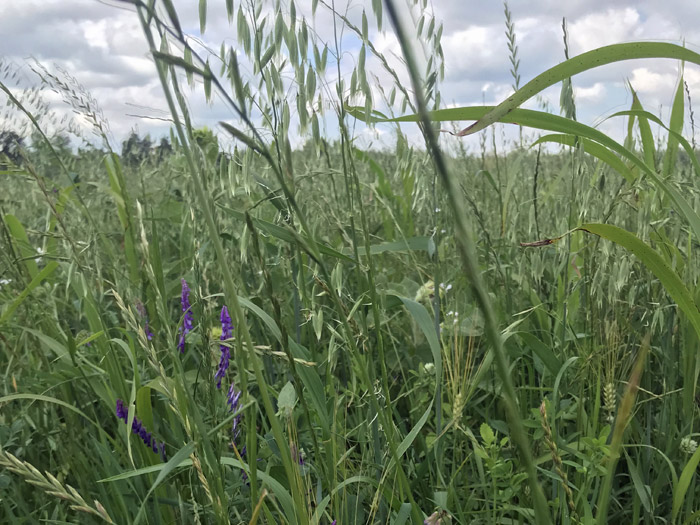If you’re among those of us who have heard about regenerative agriculture (regen ag) and are intrigued by the possibilities for your farm, yard or garden this article is for you. For those already farming, gardening or growing, regen ag is suitable for both conventional and organic management systems, large grain operations, small mixed farms and even backyard gardens, though the path each adopter takes will look slightly different. Regen ag focuses on rebuilding soil health and harnessing that living system to put it to work in your agricultural setting.
A successful transition to regenerative agriculture includes changing on-farm practices but also changing the way we see the practices we use, our management system and the contributions that the soil ecosystem make to our ability to grow healthy, quality crops. Before you start making changes, take a moment to learn the regen ag principles and consider how they will be affected by anything and everything you do.
Regen Ag Principles:
1) Keep the soil covered at all times – with plants, either living or dead (such as mulch). Keeping the sol covered a) armours it against the harsh heat of the sun, which bakes the soil ecosystem and the life in it, b) retains moisture, making it available to crops, c) protects fields from the loss of the most fertile top soils to wind erosion and c) absorbs the impact of rain, which hits bare ground with amazing force – think of each raindrop as a mini bomb going off, throwing topsoil into the air and compacting the soil below.
2) Keep a living root in the ground as long as possible – a living root in the ground holds the soil structure but it also holds a living – photosynthesizing – plant above ground. Green plants take in CO2 from the air and turn it into sugars (carbohydrates) for use within the plant. What many of us don’t realize is that anywhere from 40 to60 percent of these sugars are pumped into the soil by plants as root exudates (organic compounds deposited into soil by plant roots) that feed the microbes, such as fungi and bacteria, in the soil. These microbes in turn bring important nutrients to the plant. The more exudates a plant can put out, the bigger and more diverse a community of microbes it can support. As this community grows, it can access more space in the soil giving it more opportunities to seek out and retrieve desirable nutrients from the soil – no synthetics required.
3) Minimize soil disturbance – unless you’re using it as an intentional tool, soil disturbance should be avoided. Soil disturbance includes physical disturbance like tilling, discing and other forms of cultivation. It also includes animal disturbance, such as digging, and chemical disturbance including the use of pesticides and synthetic fertilizers. Disturbance can lead to death of soil microbes (especially fungi) if applied unchecked. However, disturbance is also a powerful tool that, when applied correctly, can be used to stimulate growth, alter community composition (for microbes and weeds) and promote healthy interactions. Don’t underestimate the power of disturbance in your system – intentional or otherwise.
4) Diversify – when in doubt, diversify. Adding diversity above ground (i.e., your crops) creates diversity below ground. A great place to start is by trying your best to add forbs (flowering plants), grasses, and legumes to all of your plantings. This can be done by including species from each functional group in your diverse crop mix, such as planting oats, peas and sunflowers together, or by planting sequentially in your rotation. For example, a year of peas could be followed by a year of oats and then a year of sunflowers. Remember, different plants put out different exudates and therefore attract and feed different soil microbes that do different jobs. Keep above-ground diversity in mind if you want to see it below ground.
5) Add livestock – whenever you have a chance, include livestock in your fields. We most commonly think of cattle in regenerative systems but diversity will optimize your system here too. Look at sheep, horses, chickens and pigs or any other animal you have access to. When live animals aren’t a practical option, consider adding manure and or compost (filled with microbial “livestock” if you will) as a source of both nutrients and organic matter for your soil. Manure and compost not only bring nutrients to your fields but also support soil structure by adding organic matter.
6) Consider your context – most importantly; becoming regenerative in your life means knowing the limitations and opportunities available to you in your context. Don’t forget to consider the financial, environmental, cultural, social, and spiritual aspects of what you’re planning to do. For example, can you afford the equipment you need to execute your plan? Or does it fit with your values? Remember to start small with what you have and don’t be afraid to share your journey with others. We all benefit from hearing about the success of our neighbours and avoiding the mishaps they’ve already learnt from!
With these principles in mind, it’s now time to sit down and figure out what you hope to accomplish by transitioning to regenerative agriculture, how you might do this and how you will do it. In other words, what are your goals, what is your plan, and what tools are available to you? A great place to start is by adding a cover crop, intercrop or relay crop to your rotation. Make sure to pay special attention to including plant species that will help you achieve your goal.
Also, take time to think about how you’ll determine whether this venture was a success or failure. Nobody plans to fail but sometimes, we all fail to plan. Start out on the right foot by planning to make time to observe, observe, observe! Take note of what you see during the growing season and why this may be happening. For this reason alone, I strongly recommend focusing your first regenerative efforts on a small piece of land that’s easily accessible (like a field you drive by daily). Set yourself up for success by making it easy to do a weekly walk through where you get a real feel for what’s going on in your field, what’s working and what unexpected benefits you may already be seeing. Don’t forget to take notes and take pictures and go back to them at the end of the season as you review your first foray into regen ag.
As we shift out of harvest and into the winter planning season – I hope you all find time to squeeze in a cover crop and see for yourselves how regen ag can work for you.




